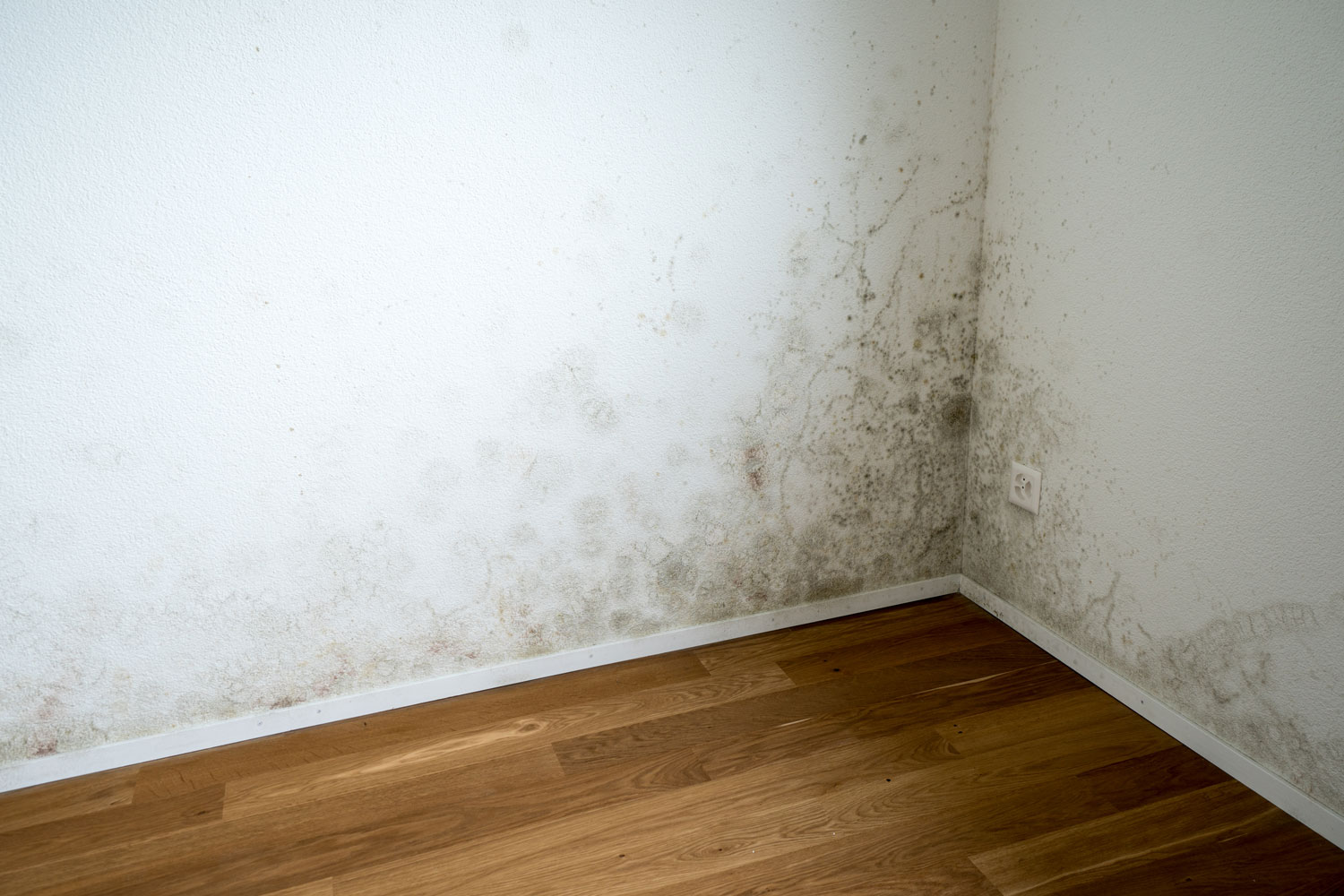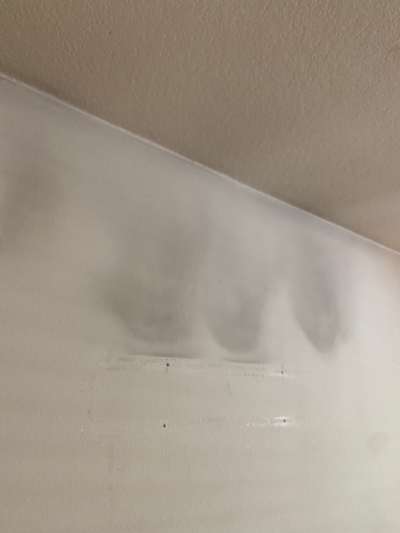
What Is Ghosting on Walls?
Ghosting on walls refers to the dark streaks or stains that appear on painted surfaces, particularly near framing studs, ceiling joists, or wall corners. These streaks occur when fine particles, such as dust, soot, or smoke, accumulate in patterns that align with the cooler sections of your walls. The cooler areas of your walls cause condensation, and this moisture traps dirt or soot, leading to visible marks that seem to “ghost” over time.
Although ghosting is often mistaken for mold or mildew, it’s important to note that it is different. Ghosting is caused by particulate buildup, while mold is the result of organic growth due to moisture and humidity.
What Causes Ghosting on Walls?
Ghosting on walls can be caused by a variety of factors, but the primary culprits are temperature differences and poor indoor air quality. Here are some of the most common causes:
1. Temperature Differences
Ghosting typically forms in cooler areas of the home where the temperature difference between the wall and the surrounding air causes condensation. For example, during the winter months, cold air from outside can cool down the walls, particularly around framing studs and ceiling joists. These cooler sections become magnets for dust, soot, and other airborne particles, which stick to the walls and leave behind dark streaks.
2. Poor Air Circulation
When your home has poor air circulation or inadequate ventilation, airborne particles have more opportunities to settle on surfaces. If air isn’t circulating properly, these particles accumulate on cooler sections of the walls, creating ghosting marks. Homes with HVAC systems that aren’t regularly maintained are particularly prone to ghosting because dirty air filters can cause excess dust and soot to circulate through the house.
3. Use of Candles or Fireplaces
Soot from candles, fireplaces, and wood stoves can contribute to ghosting on walls. When candles or fireplaces burn, they release tiny soot particles into the air. Over time, these particles stick to walls, particularly in areas where the temperature is cooler, leading to noticeable ghosting patterns.
4. Cigarette Smoke

If smoking occurs indoors, cigarette smoke can cause ghosting on walls. The fine smoke particles from cigarettes can stick to walls and ceilings, creating dark stains or streaks, especially in areas with poor ventilation.
For more detailed information on how indoor pollutants affect your home, check out the EPA’s guide on indoor air quality.
How to Prevent Ghosting on Walls
Once you’ve removed ghosting from your walls, it’s important to take steps to prevent it from coming back. Here are some effective prevention strategies to keep your walls looking clean:
1. Improve Ventilation
Proper ventilation is key to preventing ghosting. Ensure your home has adequate airflow by using exhaust fans in the kitchen and bathroom, opening windows when possible, and running ceiling fans to circulate air. Keeping air moving will help prevent particles from settling on your walls.
2. Regularly Clean Air Filters
Your HVAC system plays a huge role in maintaining indoor air quality. Make sure to regularly clean or replace your air filters to prevent dust, soot, and other airborne particles from circulating through your home. Dirty air filters are one of the main causes of particulate buildup that leads to ghosting.
3. Use High-Quality Paint
When repainting your walls, consider using high-quality, washable paints. Some modern paints are designed to resist dirt buildup and make cleaning easier. Choosing a paint with a satin or semi-gloss finish can also help, as these finishes are less likely to trap dust and soot compared to flat paints.
4. Minimize Candle and Fireplace Use
If you frequently burn candles or use a wood-burning fireplace, consider cutting back to reduce the amount of soot in the air. Choose candles made from cleaner-burning materials like soy or beeswax, and keep fireplaces and wood stoves well-maintained to minimize soot production.
5. Seal Air Leaks
Cold air leaking into your home can create cooler sections on your walls, contributing to ghosting. Check for air leaks around windows, doors, and electrical outlets, and seal them with caulking or weatherstripping to keep your home better insulated and reduce temperature differences.
How to Clean and Remove Ghosting from Walls

If ghosting has already occurred on your walls, it’s important to clean it properly to prevent further staining. Here’s a step-by-step guide to removing ghosting from walls:
| Step | How to Do It |
|---|---|
| 1. Dust and Vacuum the Area | Before cleaning, use a microfiber cloth or duster to remove surface dust from the wall. You can also use a vacuum with a brush attachment to suck up any loose dust particles. This will prevent dirt from spreading or scratching the wall as you clean. |
| 2. Make a Cleaning Solution | For light ghosting marks, you can use a solution of warm water and a mild dish soap. If the stains are more stubborn, mix one cup of white vinegar with two cups of warm water to create a natural cleaning solution. Vinegar helps break down soot and smoke particles, making it ideal for tough stains. |
| 3. Scrub Gently | Dip a soft sponge or cloth into the cleaning solution and gently scrub the affected areas of the wall. Avoid using abrasive scrubbers, as they may damage the paint. Be sure to rinse the sponge frequently to avoid spreading dirt. |
| 4. Rinse and Dry the Area | Once the ghosting marks are gone, wipe the area with a clean, damp cloth to remove any remaining soap or vinegar residue. Afterward, use a dry towel to dry the wall completely. Proper drying is essential to prevent moisture from seeping into the walls. |
| 5. Repaint If Necessary | If ghosting has stained the wall beyond cleaning, it may be necessary to repaint. Choose a high-quality, washable paint to prevent future ghosting and make cleaning easier in the long run. |
If the ghosting is severe or keeps returning despite cleaning efforts, it may indicate a larger underlying issue such as insulation problems or poor air quality. In these cases, it’s best to consult with a professional for an inspection. Citywide Mold Mitigation can help identify the cause of ghosting and offer solutions to prevent it from recurring.
When to Call Citywide Mold Mitigation for Help
If you’ve tried cleaning your walls and the ghosting keeps coming back, it may be time to call in the experts. Persistent ghosting can be a sign of poor insulation, ventilation issues, or hidden moisture problems that need professional attention. Citywide Mold Mitigation provides expert inspections, moisture control solutions, and indoor air quality improvements to address the root cause of ghosting on walls.
FAQ
| Question | Answer |
|---|---|
| Is ghosting on walls harmful? | Ghosting itself is not harmful, but it can be a sign of poor indoor air quality or ventilation issues. If left untreated, ghosting can make your walls look dirty and may contribute to the buildup of dust or soot in your home. |
| How do I know if ghosting is caused by mold? | Ghosting and mold can look similar, but they have different causes. Ghosting is caused by particulate buildup, while mold is the result of moisture and organic growth. If the streaks wipe off easily or match the pattern of framing studs, it’s likely ghosting. For more serious cases, professional mold inspection may be necessary. |
| Can ghosting on walls be prevented? | Yes, you can prevent ghosting by improving ventilation, regularly cleaning air filters, sealing air leaks, and reducing the use of candles or fireplaces. Using high-quality paint and keeping surfaces clean can also help reduce ghosting. |
| Why does ghosting occur more in winter? | Ghosting is more common in winter because the colder outdoor temperatures cool down certain sections of the walls. This temperature difference causes condensation, which attracts dust, soot, and other airborne particles, leading to ghosting marks. |
| When should I call a professional for ghosting issues? | If ghosting persists despite cleaning or if it indicates larger insulation or ventilation problems, it’s best to call a professional like Citywide Mold Mitigation for a thorough inspection and long-term solution. |
If you’re dealing with persistent ghosting on your walls, contact Citywide Mold Mitigation for expert help in addressing the root causes and ensuring your home stays clean and free of unsightly stains.

